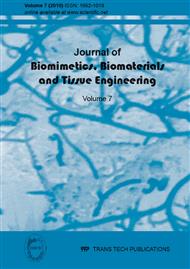p.1
p.7
p.27
p.55
p.81
Organic Solvent Traces in Fibrillar Scaffolds for Tissue Engineering
Abstract:
In the present study the amount of xylene remaining in fibrillar scaffolds after their manufacture has been estimated by means of Gas Chromatrography coupled to Mass Spectrometry (GC-MS). For this purpose model scaffolds of poly(ethylene terephthalate) (PET) comprised of microfibrils with diameters of ~1 µm or nanofibrils with diameters of 50-150 nm as well as microfibrillar scaffolds of poly(glycolic acid) (PGA) have been used. An extremely low initial amount of xylene has been found (< 20 ppm). The xylene amount dropped below 2 ppm after drying for 24 h in a vacuum at 80°C. The microfibrillar PGA scaffolds, initially containing more xylene (23.4 ppm), retained only 3.6 ppm after drying for 24 h. After drying for 48 h the amount of xylene in all the scaffolds studied reached the detection limits of the GC-MS apparatus (< 0.5 ppm).
Info:
Periodical:
Pages:
1-6
Citation:
Online since:
October 2010
Authors:
Price:
Сopyright:
© 2010 Trans Tech Publications Ltd. All Rights Reserved
Share:
Citation:


